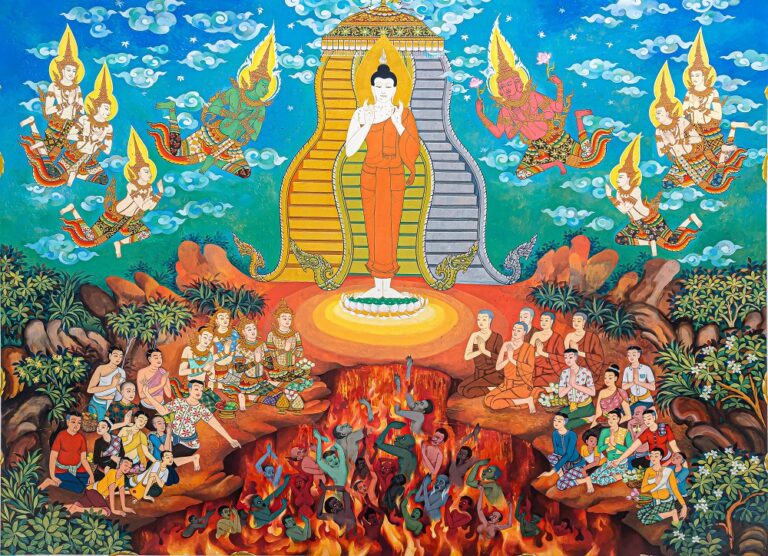
THE DESCENT FROM HEAVEN
The events shown in this mural occur directly after the Buddha preached the Abhidhamma in Tavatimsa Heaven.
When the rainy season ended, the Buddha was granted leave by the god of Tavatimsa Heaven to return to earth. On Mahapavarana day, the “day of leaving the rains retreat,” he descended to earth on a jewelled staircase, standing on a lotus. (As we see in this mural) Sakka, king of the devas, had also created three gilded stairways for the Buddha’s heavenly disciples, devas and brahmas, to accompany him back down to the human realm. The gold staircase was for the devas, the silver for the Brahmas, and the lotus-green jewelled one in the centre was for the Buddha.
As the Buddha stood on the jewelled staircase, he revealed all the worlds at once: the heavenly realms of the devas, the earthly world of human beings, and the realms of hell. The Buddha “opened the worlds” so that all beings could see the effects of good or bad karma, and so that Buddhahood would be pursued by all beings.
Sankassa, one of the eight traditional Buddhist pilgrimage sites, is where the Buddha is said to have descended to earth after preaching in Tavatimsa Heaven. The place where he stepped onto earth is known as the “Buddha’s footprint” and is now believed to be located in Sankisa Basantapura on the north bank of the Ikkhumatī, between Kampil and Kannauj, approximately 23 miles west of Fatehgarh and 45 miles north of Kannauj in India.
In Theravada Buddhism, the end of the three-month Vassa period is marked by the observance of Mahapavarana, during which a special almsgiving ceremony known as Tak Bat Devo is performed. The name of the ceremony, which translates to “alms given after descending from the deva realm,” reflects the belief that it is performed in honor of the Buddha’s return to the human realm after preaching in Tavatimsa Heaven.